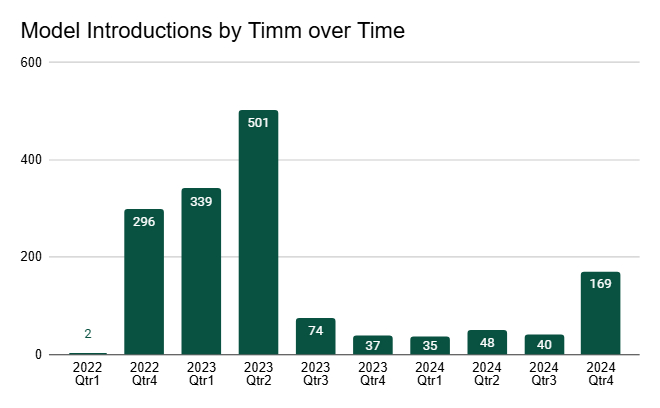🚀📚 Biggest Trend in Machine Learning Highlighted by One Set of Libraries 🤖✨
Would you like to be featured in our newsletter🔥 and get noticed, QUICKLY 🚀? Simply reply to this email or send an email to editor@aibuzz.news, and we can take it from there.
How One Person Can Drive Enormous Change
Liftr Insights has been tracking a wide range of AI and ML projects. Among them, PyTorch Image Models (Timm) stands out. With over 160 million downloads in February 2025, Timm has emerged as the most popular computer vision library. That figure marks a 199% increase over December 2024, highlighting a dramatic surge in adoption. But what’s driving this rapid acceleration?
PyTorch Surges as TensorFlow Declines
Timm outpaced the second most downloaded computer vision library by more than 2-to-1.
Timm is the author of a collection of vision-based deep learning libraries built on the PyTorch ecosystem. PyTorch was released as a suite of vendor-neutral, open-source tools designed to work together. PyTorch, supported by AWS, Microsoft, and even Google, has gained popularity as a more flexible alternative to TensorFlow, which Google released in 2015. Despite being open source, TensorFlow has lost momentum, especially in computer vision use cases.
In recent data, TensorFlow accounted for only a handful of downloads (i.e., 383) compared to just short of 400,000,000 of models with PyTorch included.
Timm has successfully ridden the wave of PyTorch’s growth. In fact, it outpaced the second most downloaded computer vision library(from Meta/Facebook) by more than 2-to-1. Even more remarkable is that Timm is an open-source project created and maintained by a single software engineer, Ross Wightman. Its vendor-neutral nature has enabled Ross and community contributors to prioritize user needs over business goals.
Timm’s Contributions Are Scaling with Usage
Neutrality and community focus aren’t the only reasons for Timm’s success. Sustained momentum also requires frequent updates and a deep alignment with developer needs—an area where Timm shines.
As of February 2025, Timm has authored 1,595 models, a 3.2% increase from the previous month.
The sheer volume and quality of contributions have helped stand apart. On average, Timm models receive over 1,500% more downloads than other computer vision models, and their median downloads are over 3,000% higher.
February 2025 Computer Vision Comparison

Standout Models Powering Growth
Among Timm’s extensive model collection, a few key models dominate usage:
timm/mobilenetv3_small_100.lamb_in1k
timm/resnet50.a1_in1k
timm/resnet18.a1_in1k
These three alone account for over 150 million of February’s 160+ million downloads. Notably, they were created back in 2022 and 2023, before the explosion of mainstream AI interest—making their sustained dominance especially impressive.
Timm Makes Inferencing Scalable and Affordable
While training costs can be significant, Timm supports efficient inference at scale—even on low-power devices. For example:
ResNet-based models can run on devices like the NVIDIA Jetson Nano, or modern Mac/PCs with acceleration.
Cloud inference costs (based on Liftr data) on AWS for as low as $0.63 per hour to over $100 per hour, depending on instance type and performance needs, with an global average of $3.95 per hour.
Open-Source Popularity Influences Enterprise Decisions
Popularity attracts a large pool of experienced developers, accelerating time to production.
Projects like PyTorch and Timm are:
Low-risk and widely adopted: Open-source status ensures community longevity and protection from vendor lock-in.
Highly integrable: Timm's compatibility with other ML tools increases enterprise agility.
Community-supported: Its popularity attracts a large pool of experienced AI developers, accelerating time to production.
By contrast, libraries developed within a corporate silo (like some Meta-led projects) may lack the same broad utility and developer trust.
Conclusion
One of open source's greatest strengths is that a single contributor or small group can drive outsized industry impact. While big corporations dominate headlines, stories like Ross Wightman’s Timm project show that individuals still shape the AI landscape in profound ways. Timm is a great example of this phenomenon, and its enormous popularity and adoption are helping developers of all kinds leverage computer vision applications in many industries.
Liftr Insights will continue to keep an eye on AI for intriguing points of note and the data behind them. The next article in this Liftr AI series, which will uncover hidden insights about another critical AI model trend. You can also explore our earlier pieces on AI infrastructure and semiconductor trends, including our series about ARM.
To stay current and informed and to be the first to know about the latest reports like these, subscribe to the Liftr Newsletter.




